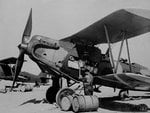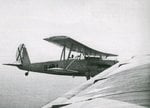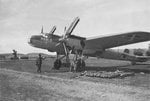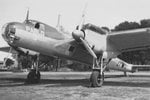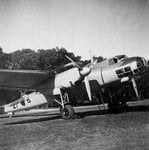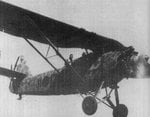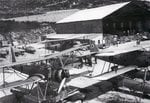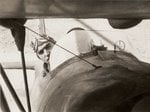- Thread starter
- #41
The Heinkel He 45 was a light bomber produced in Germany in the early 1930s, one of the first aircraft adopted by the newly-formed Luftwaffe. Its appearance was that of a conventional biplane and included seating for pilot and gunner in tandem, open cockpits. Developed in parallel with the He 46, it appeared in 1931 as a general-purpose biplane and was employed mainly as a trainer, but was also used by the Luftwaffe for reconnaissance and light bombing duties. Production of this plane totalled 512 aircraft, including those built under licence by Gotha, Focke-Wulf, and BFW.
Attachments
-
 Heinkel He-45 Pavo 001.jpg110.2 KB · Views: 513
Heinkel He-45 Pavo 001.jpg110.2 KB · Views: 513 -
 Heinkel He-45 Pavo 002.jpg116.4 KB · Views: 517
Heinkel He-45 Pavo 002.jpg116.4 KB · Views: 517 -
 Heinkel He-45 Pavo 003.jpg127.3 KB · Views: 507
Heinkel He-45 Pavo 003.jpg127.3 KB · Views: 507 -
 Heinkel He-45 Pavo 004.jpg131.7 KB · Views: 507
Heinkel He-45 Pavo 004.jpg131.7 KB · Views: 507 -
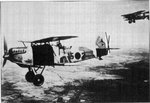 Heinkel He-45 Pavo 005.jpg197.6 KB · Views: 500
Heinkel He-45 Pavo 005.jpg197.6 KB · Views: 500 -
 He45A88LC.jpg74.8 KB · Views: 386
He45A88LC.jpg74.8 KB · Views: 386 -
 Heinkel He-45 Pavo 0012.jpg129 KB · Views: 797
Heinkel He-45 Pavo 0012.jpg129 KB · Views: 797 -
 Heinkel He-45 Pavo 0013.jpg112.7 KB · Views: 370
Heinkel He-45 Pavo 0013.jpg112.7 KB · Views: 370 -
 Heinkel He-45 Pavo 0014.jpg81.3 KB · Views: 360
Heinkel He-45 Pavo 0014.jpg81.3 KB · Views: 360 -
 Heinkel He-45 Pavo 0015.jpg130 KB · Views: 382
Heinkel He-45 Pavo 0015.jpg130 KB · Views: 382 -
 Heinkel He-45 Pavo 0016.jpg90.5 KB · Views: 384
Heinkel He-45 Pavo 0016.jpg90.5 KB · Views: 384 -
 Heinkel He-45 Pavo 0017.jpg67.3 KB · Views: 368
Heinkel He-45 Pavo 0017.jpg67.3 KB · Views: 368 -
 Heinkel He-45 Pavo 0018.jpg83.9 KB · Views: 374
Heinkel He-45 Pavo 0018.jpg83.9 KB · Views: 374 -
 Heinkel He-45 Pavo 0019.jpg97.9 KB · Views: 379
Heinkel He-45 Pavo 0019.jpg97.9 KB · Views: 379 -
 Heinkel He-45 Pavo 0020.jpg120.3 KB · Views: 369
Heinkel He-45 Pavo 0020.jpg120.3 KB · Views: 369 -
 Heinkel He-45 Pavo 0021.jpg77.4 KB · Views: 380
Heinkel He-45 Pavo 0021.jpg77.4 KB · Views: 380 -
 Heinkel He-45 Pavo 0022.jpg95.7 KB · Views: 373
Heinkel He-45 Pavo 0022.jpg95.7 KB · Views: 373 -
 Heinkel He-45 Pavo 0023.jpg88.1 KB · Views: 369
Heinkel He-45 Pavo 0023.jpg88.1 KB · Views: 369 -
 Heinkel He-45 Pavo 0024.jpg74.7 KB · Views: 353
Heinkel He-45 Pavo 0024.jpg74.7 KB · Views: 353 -
 Heinkel He-45 Pavo 0025.jpg90.6 KB · Views: 377
Heinkel He-45 Pavo 0025.jpg90.6 KB · Views: 377 -
 Heinkel He-45 Pavo 0026.jpg84.1 KB · Views: 376
Heinkel He-45 Pavo 0026.jpg84.1 KB · Views: 376 -
 Heinkel He-45 Pavo 0027.jpg129.4 KB · Views: 373
Heinkel He-45 Pavo 0027.jpg129.4 KB · Views: 373 -
 Heinkel He-45 Pavo 0028.jpg98.8 KB · Views: 374
Heinkel He-45 Pavo 0028.jpg98.8 KB · Views: 374 -
 avc_00249808.jpg95.4 KB · Views: 342
avc_00249808.jpg95.4 KB · Views: 342
Last edited:
















